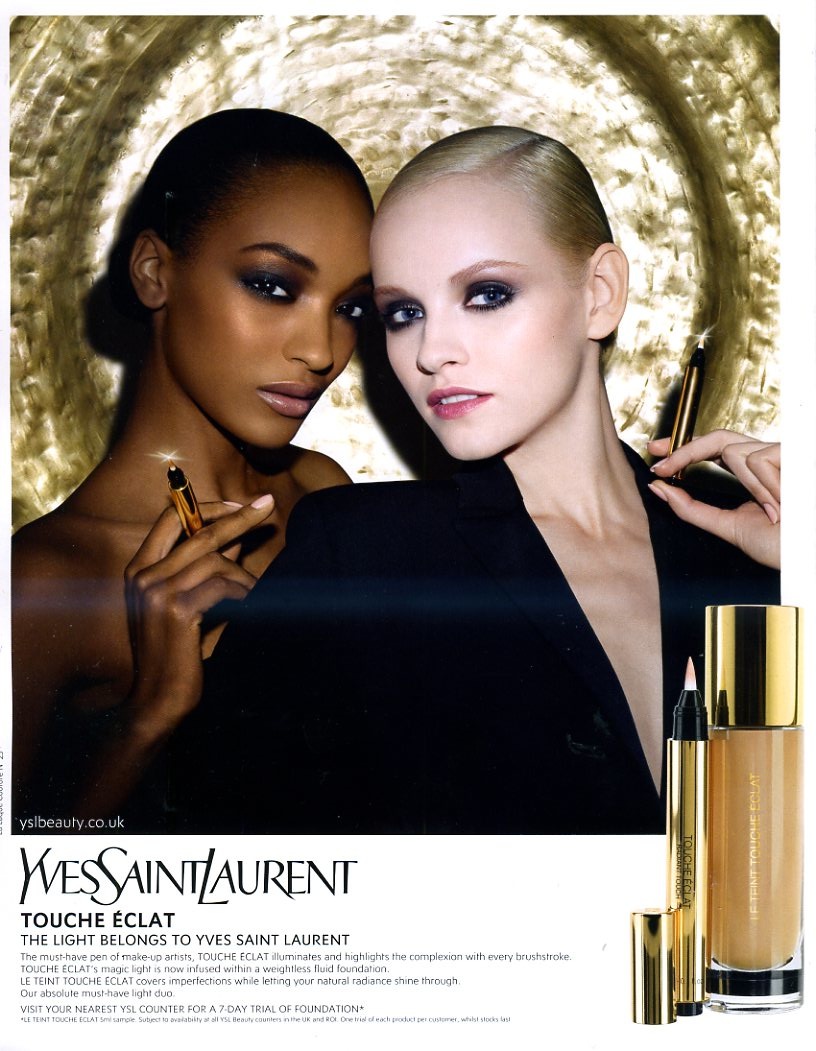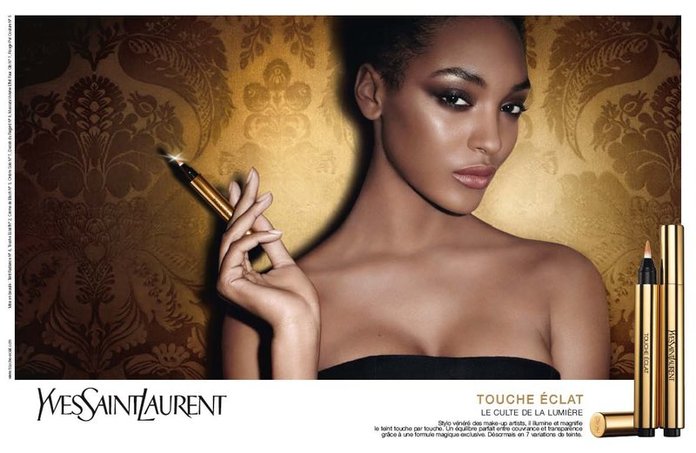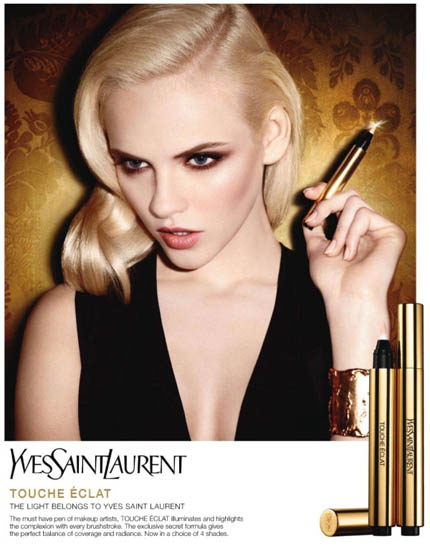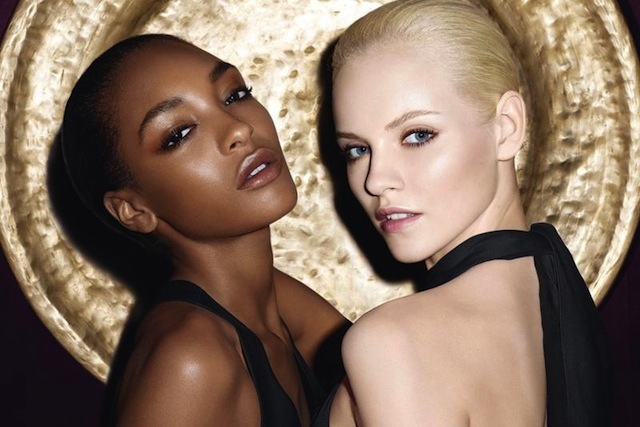Last week Charles Reece, Sarah Shoker and I had a conversation in comments about authenticity, plastic surgery, commerce, make-up and other things. Along those lines, I thought it might be interesting to talk about this back-cover ad for from the May issue of Vogue for the Touche Éclat make-up pen, featuring models Jourdan Dunn and Ginita Lapina.
“Le Tent Touche Éclat covers imperfections while letting your natural radiance shine through,” according to the copy.
As that suggests, the ad, like a lot of fashion, is deliberately playing with tropes of naturalness and artificiality. The make-up pens stand in for cigarettes — which in turn stand-in for phalluses, so that applying make-up becomes, all at once, socially (not to mention physicaly) dangerous, a tease for a male(?) viewer and an assertion of sexual power. Moreover, the two women — with their similar smooth styling, poses, head tilts, and standard smoldering stares — double each other, artificially cloning the others’ look. White becomes mimicking of a (natural?) black, while black becomes a micmicking of a (natural?) white. The doubling creates a standard (everyone is doing it) and suggests there is no unitary standard (doubling is uncanny.) Similarly, the weird gold nowhere against which they pose contrasts with the simplicity of their outfits; Dunn’s black dress is so low cut that she’s au natural for all practical purposes, while Lapina appears in unadorned black (with plunging neckline.)
IN part, the ad uses the natural/artificial binary as a lever to commodify naturalness. Dunn and Lapina become multiplied, deindividualized icons — carefully arranged compositional elements in someone’s, or everyone’s, golden dream. The repetition of their diverse natural, individual selves tends to make those selves, in their naturalness and diversity, replicable, and therefore available and purchaseable. With makeup, you two can be as individual as them.
You need this individuality, or uniqueness, or (if you prefer) authenticity if the transaction is going to be appealing or exciting. It’s not just being able to purchase a replicable thing; it’s the sense that the replicable thing purchased is special. That’s the appeal of the interracial models. But it’s also the appeal of the inevitably controversial cigarette imagery. And, for that matter, of the connotations you set up when you put a black woman and a white woman together, each wielding a penis substitute — cultural discourses around prison butches and interracial lesbianism are buried, but not, imagery like this suggests, utterly forgotten. As Tom Frank has pointed out over and over, controversy and rebellion sell; nonconformity is the most exciting conformity of all.
The market, then, takes any form of authenticity or individuality, and turns it into an image of itself, so you’re buying back your own natural radiance to be applied artificially, or purchasing markers of rebellion (interracial mixing, lesbianism, cigarettes) just like everybody else.
Capitalism’s de-authentification of everything can certainly be depressing and constricting, demanding that women conform their real bodies to impossible standards (I’m sure the image here has been extensively photshopped, like all images in fashion mags.) On the other hand, though, it’s hard not to see some appeal in the artificiality as well. Where is this world we are being shown, where race is interchangeable, where deviant sexuality is glamourous and fabulous rather than marginalized and persecuted, where beautiful bodies float free of social stricture or even — as cigarettes become mere style icons — fear of cancer? It’s easy to say, well, interracial fraternization and even hints of lesbianism aren’t scandalous any more — but that “any more” is pretty recent. Forty years ago, this image would probably have been unprintable in a mainstream publication. Today, it’s being used to sell cosmetics.
If the problem with capitalism is that it makes rebellion conventional, then the upside of capitalism is that it makes rebellion conventional. And the way it does that, in part, is through a relentless assault on authenticity.There is no norm but the market, before whom the only differences that matter are desires, and all desires are equal. Everything is surface and style, which means that every proscription — against blacks, against gays, against smoking — is waved away as long as you are beautiful enough and have the right products.
That gold, glowing background, then, can be seen as capitalism itself — the mystic n-space that turns bodies and individuals into their own perfect replicas. The only morality there is that little bit of glowing glamor you can grab, the only pleasure the thrill of letting that glamor swallow the self in its brightness. Is disappearing into the brightness freedom, or is it nothing left to lose? It probably depends on what you had to lose in the first place, ow what you think you can get in exchange for your soul. Or maybe, as Waylon Jennings said in an authentic, wise song you can purchase in replicable digital form on I-Tunes, “Sometimes it’s heaven, sometimes it’s hell, sometimes I don’t even know.”





I thought you were reaching with the lesbian angle until I got to the last photo.
You could also talk about the kind of ‘lesbianism’ being shown here. They’re both looking at the camera. Jourdann Dunn is angled toward Ginita Lapina – is embracing her with a hand on her shoulder or has her body arced toward her. There’s a wariness to her expression, ‘I don’t trust you but I’ll let you take my picture anyway’.
She also has that guarded feeling in her individual shot, so it could just be her personality as a model, but in a spread where we’re supposed to imagine a lesbian (illicit) relationship between them I find her way more believable than Ginita Lapina, who in all cases is focused on, and solicitous of, the camera. Even when her body is turned towards Dunn’s in the last shot, the camera still has her attention and love.
So now in addition to the phallic makeup tubes (cum masculine cigarettes) that are posed to invade the bedrooms/bathrooms of women, you have women being ‘lesbians’, where ‘lesbians’ means making erotic faces while loosely standing together while really looking at camera/the male gaze. If Jourdann Dunn didn’t have that mistrustful expression and wasn’t doing most of the body language work, there’d be no hint of anything between the two of them being captured here.
So this makes me wonder about the racial politics of the pairing, and whether we’d be likely to see it the other way around (black model focused on camera/white model focused on black model). Maybe in an ad that was mostly targeted at black women? Because the fantasy is a fantasy of not making moves of your own, while still receiving someone else’s attention.
The women-in-prison interracial lesbian trope is that the black woman is the aggressor, the white woman is the innocent seduced. So blackness becomes a marker of maleness/butchness, basically. Which certainly works with this, where Lapetti is focused on a (male?) camera, and Dunn seems more reserved/mistrustful/self-contained.
I bet the reverse — where the white woman is signaled as more dominant or reserved or in control — would be…tricky to pull off. You’d start activating the history of racial oppression in a way that I bet advertisers would in general rather not.
Wow, this just condenses something I particularly hate in our current consumer culture: fake rebellion.
Noah, you’ve lined up the corrupt themes very cannilly. Fake Lesbianism that doesn’t even need to be expressed; the vacuous ambiguity of those poses allows timid populuxe readers to thrill to “forbidden” areas of humanity at no risk.
Your point on their ‘cigarette’ metaphor is even apter.
What is more reviled than tobacco in our 21st century America? So the suggestion of cigarette smoking is perceived as DARING.
Fake, fake, fake.
Do you remember an ’80s so-called “punk” band called Sigue Sigue Sputnik? It was entirely co-opted by a major music publisher.
Had some initial success, but the Punks and, afterwards, the Punters stayed away in droves.
There can definitely be something revolting in the artifice of fashion….
I was trying to say, though, that there’s something attractive too. I don’t think it’s an accident that there are so many gay men attracted to this world. You can see how it might be a relief after a lifetime of having your authenticity questioned to be in a place where those questions aren’t really raised….
Sort of tying that to Subdee’s point..the imagined viewer in fashion is often actually a gay man, I think. So in some ways the lesbianism can be seen not so much as fake as displaced; there is actually gayness in this image (and most fashion iamges), but its gender and location are being shifted….
Well, I know this is a cliché but it is true: a high proportion of men working in the fashion industry are gay.
BTW, I know this from personal experience.
I was a child model from 1958 to 1968, with appearances in Vogue, Life, McCall’s, Saturday Evening Post, and Paris Match among others; photographed by Art Kane and Peter Basch.
I was agented by the Ford agency; I still remember Eileen and Jerry Ford buying me Sundaes at Schrafft’s.
So silly, so long agao.
I didn’t say anything about gay men, in particular, but yeah I do think there’s a palpably male gaze at work here. Even the way the models are dressed in clothes that emphasize their shoulders, necks, and backs (sexy body parts for either gender).
It’s just that bit more bizarre in an advertisement for makeup. Although, thinking about it, it would easier for a man to use cosmetics that are ostensibly for women than it would be to wear clothes or shoes that are tailored for women’s bodies. The market of men who wear makeup has got to be much smaller than the market of women who wear makeup, though. Probably this is just keeping up the brand cache by associating it with the high-status world of high-fashion, which is androgynous and male.
Well…as Sharon Marcus has said, there’s often very much an eroticized female gaze in fashion — that is, female bodies presented erotically for female viewers, often as part of a heterosexual female identity (in which eroticized female-female looking is sanctioned.) So..I think that the fact that the image is eroticized doesn’t mean it’s aimed at men. And I think that the fact that it’s a lesbian image (at least in part) is actually a tease/signal to female viewers that they can/should look at this image erotically.
If that makes sense?
And Alex…holy crap! That’s amazing.
There aren’t pictures floating around the web, are there?
It’s not male gaze because it’s eroticized, it’s male gaze because there are phallic symbols and whatnot :p
I think it gets tricky, though, because *any* eroticized gaze tends to read as, and partly be eroticized because, it’s male.
That is, women in the eroticized position of male viewer are in the eroticized position of male viewer. Showing women holding phallic symbols could be seen as giving women the phallus; i.e., the one doing the erotic viewing is female, not male.
There’s just a lot of cross-identification and cross-viewing in fashion, I think. Gender and sexuality are just really presented as very fluid in these images….
Alex – can we expect the “I was a Ford male child model” memoir soon? And, yes, link us to some images please.
—————————
Noah Berlatsky says:
There can definitely be something revolting in the artifice of fashion…
—————————-
Yes; the holding up of unattainable, inhuman perfection; pseudo-rebelliousness; cynical exploitation of sexual/racial areas…
But, “artifice” can harmlessly be imaginative, amusing, bizarre, or simply ridiculous:
Bjork; http://theraspberrystain.thebutterflyfx.com/images/Stylewalksplanett/biork-1.jpg
http://www.dexigner.com/news/20606
The first four photos at http://tokyofashion.com/tag/extreme-fashion/ …
————————-
I was trying to say, though, that there’s something attractive too. I don’t think it’s an accident that there are so many gay men attracted to this world. You can see how it might be a relief after a lifetime of having your authenticity questioned to be in a place where those questions aren’t really raised….
————————–
Unlike those historic Jews who turned to finance and “usury” because they were driven out of other occupations (starting with farming), I don’t think gay guys are driven into fashion: “Oh, good, here’s a place where my ‘authenticity’ won’t be questioned!”
Indeed, it seems t’me that they routinely delight in aesthetically inspired artificiality; it’s not down-to-earth women that win their admiration and imitation, but larger-than-live divas like Garland, Streisand.
From Oscar Wilde:
—————————-
“The one charm about marriage is that it makes a life of deception absolutely necessary for both parties.”
“Man is least himself when he talks in his own person. Give him a mask, and he will tell you the truth.”
——————————–
BTW, is that gold background behind the “mannequins” in the first shot (looks like a hammered-metal plate) not reminiscent of a halo? Or a Van Gogh Sun?
Can one not make the case that calling every cylindrical object around a “penis substitute” is reminiscent of phallocentrism, “The privileging of the phallus in understanding meaning or social relations”?
Howcum every torus shape doesn’t get similar treatment? “Look at those fat cops, munching on ‘vagina substitutes’!”
Those “cigarette substitutes” being waved around to exploit the now-“forbidden pleasure” aspect of tobacco, reminds of Edward Bernays, P.R. and advertising mastermind, who brought into the field discoveries in psychology, the better to manipulate the masses for political and commercial aims.
In his massively influential 1928 “Propaganda” (poor Bernays was dismayed to hear the Nazis later used its techniques; who would’ve thought?)…
———————
Bernays places great importance on the ability of a propaganda producer, as he views himself, to unlock the motives behind an individual’s desires, not simply the reason an individual might offer. He argues, “Man’s thoughts and actions are compensatory substitutes for desires which he has been obliged to suppress.”
Bernays suggests that propaganda may become increasingly effective and influential through the discovery of audiences’ hidden motives. He asserts that the emotional response inherently present in propaganda limits the audience’s choices by creating a binary mentality, which can result in quicker, more enthused responses…
————————
http://en.wikipedia.org/wiki/Propaganda_%28book%29
The “Suffragettes and Cigarettes” section at http://tinyurl.com/aygvp57 shows how Bernays tied in the fight for women’s rights with cigarettes, describing the cancer-sticks as “torches of liberty”…